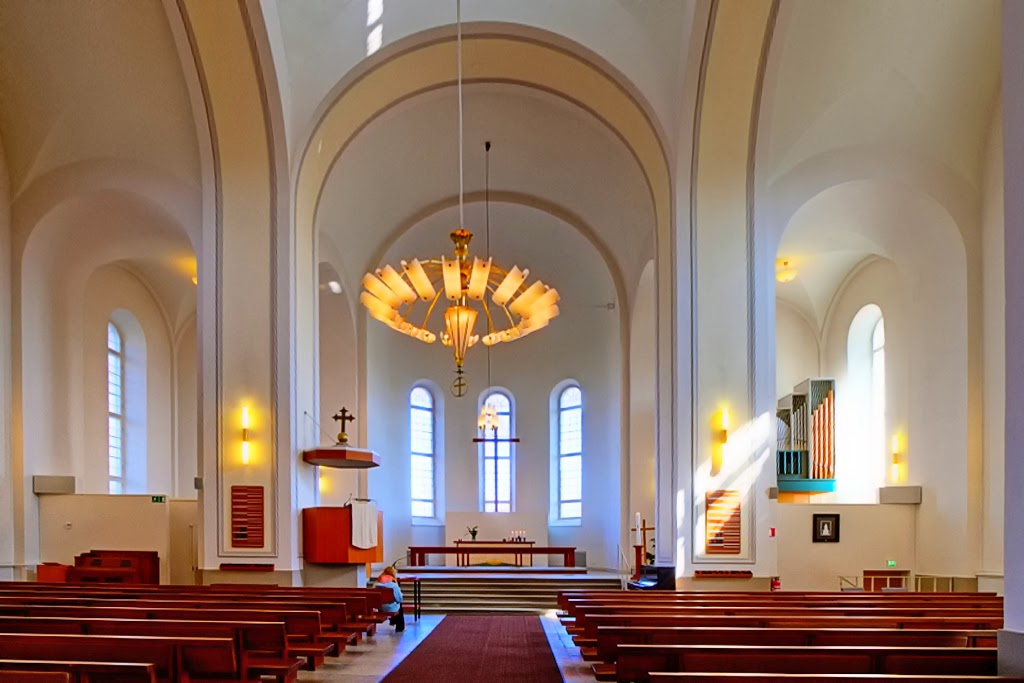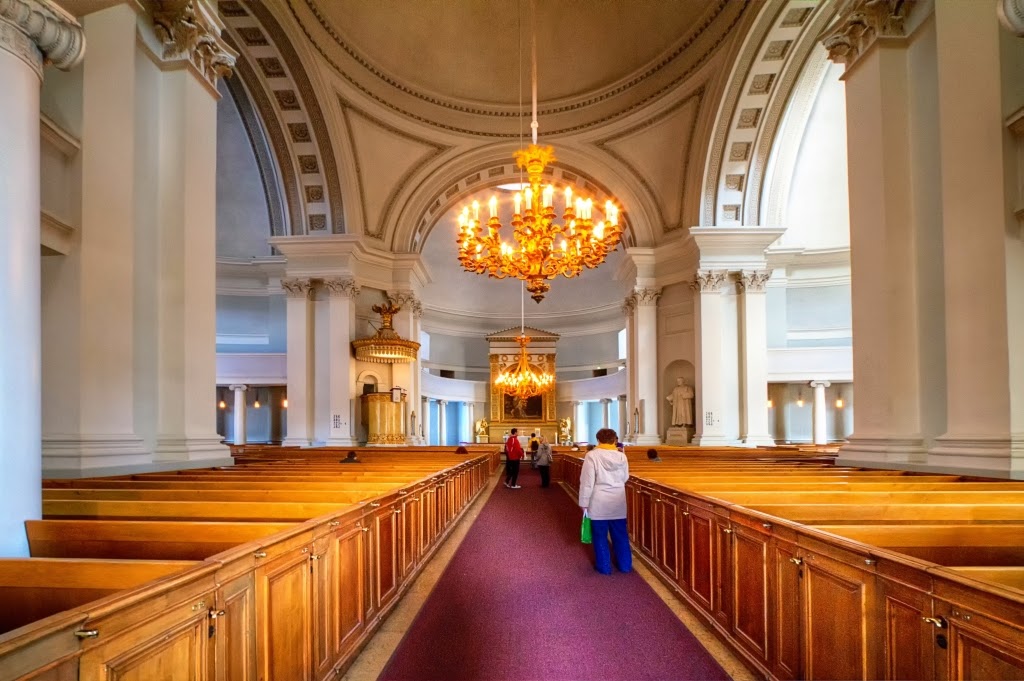We got up not tooo early, and caught the
metro down to Helsinki. Our destination was Suomenlinna, The Suomenlinna
maritime fortress, is more than 260 years old, is a Unesco World Heritage
Site and one of the most popular sights in Finland. The walls of the fortress
can be seen all over Suomenlinna,
We met all met Sari at the ferry, got our
tickets then hopped on the boat. It was only a short 5-10 minute ride to the
island.
I will at this stage tell you that despite
the blue skies, it was FREEZING. A bitterly cold wind, and I don't think it got
above 6C all day. I was glad to borrow one of Jaana's coats.
First stop off the boat was the
Suomenlinna Church. It was originally was built as a Russian Orthodox garrison
church in 1854. The original building had five steeples with onion domes. The
appearance of the church – which dominates the southern horizon from Helsinki –
was changed at the beginning of the Finnish era in the 1920s, when it was
converted into an Evangelical-Lutheran church.
Inside was seating enough for 400 people.
To be honest it didn't look that big. I loved the simplicity inside, and
the beautiful light hanging from the dome. The church steeple doubles as a
lighthouse for air and sea traffic. The signal blink of the lighthouse is the
Morse code for the letter “H” for Helsinki. This is something I noticed when I
was in Tallinn two days earlier - as we docked I noticed all the churches had
flashing lights - obviously doubling up as lighthouses.
After we had explored the church we set upon the rest of the
island. Up this road then left through an arch in the building and we came
across the Great Courtyard.
The courtyard was completed in the 1760s,
designed by the architect Augustin Ehrensvärd, and served as the main square of
the fortress. The houses surrounding the courtyard included the fortress
commandant’s house and the main guard house.
The Great Courtyard was badly damaged
during the Crimean War in 1855, but it is still an impressive sight. The grave
of Augustin Ehrensvärd lies in the courtyard (below), surrounded today by the
Ehrensvärd museum and some residential buildings.
This is what the stone buildings looked
like inside. I imagine they would have been used for storage of armaments.
On our walk we came across a couple of canons
and we had a bit of fun with them...
Barracks - bright yellow and wooden.
A few locals were checking us out. In case
you didn't know, these are Egyptian Geese.
Anne waited for me to catch up to everyone
as I had got behind photographing the birds. It was cold, but at least here she
would have been out of the terrible wind.
To give you an idea how cold it was - that
is S N O W! Note how rocky the coast is. I noticed that Finland itself was very
rocky, and lots of little islands - all quite flat - nothing very high above
sea level.
We climbed up to the canons for a look...
Took a couple of photos...
But didn't hang around for long up there, once again because of
the cold. Also - although the sky was blue in that direction, a huge rain/storm
cloud was following behind us!
Sari the photographer extraordinaire...
In front of a store house... These are
just built into the hillsides.
We wonder if this was a swimming pool, or
a water reservoir. We never did find out.
Another storage facility built into the hillside.
At this stage it was so cold, we found a
pizza place an stopped in for some hot drinks and to thaw out. We had a great
time and I later found out that Pizza place was world famous. Had I known, I
would have tried some food! I was very reluctant to get back out in the cold
again!
This is the Kings Gate and the symbol
of Suomenlinna. It was built between 1753 and 1754 as the entrance gateway to
the fortress. The gate was built on the site where the ship carrying the
founder of the fortress, King Adolf Frederick of Sweden, was anchored while he
inspected the construction of the fortress in 1752. It too was damaged in the
Crimean war, and has been refurbished a few times since.
Sari - the Pro Photographer...
We decided it was too cold to hang around
much longer, so headed back through the tunnel and back to the ferry.
We could see Helsinki in the distance, and
could see the Cathedral clearly.
Back on dry land, we met another of Jaana's
friends - also called Sari. We are wondering if Jaana makes friends with all
the same name, to make it easier for her to remember names! Sari was a
specialist in Finnish History so was an excellent companion in our sightseeing.
She talked about the architecture around Helsinki and told us the
architects were Russian. It was really interesting. I wish I had
taken notes! These next two images show the houses along the waterfront and
docks, and these were originally the first houses of wealthy merchants.
You can see the Greek Orthodox Church in
the distance which we visited the day before..
Sari holding the history book, while Sari
points out the buildings.
Sari makes an excellent bookstand - a
woman of many talents - photographer - bookstand....
We then stopped for lunch at an Italian
restaurant - again a nice warm up with good food. By now the day was nearly
over - so we jumped on a tram afterwards and was taken to The Church in the
Rock. While on the Tram we looked out the window to see a guy peeing in the
middle of the street. Jaana explained that drinking problems are rampant in
Finland. Very sad.
The Church in the Rock was amazing. The
Architecture incredible. The entrance was quite ordinary, but once through it
was amazing...
Temppeliaukio Church
or Temppeliaukion kirkko, is a Lutheran church in the Töölö
neighborhood of Helsinki. The church was designed by architects and brothers
Timo and Tuomo Suomalainen and opened in 1969. It is also known as the Church
of the Rock.
The interior was excavated and built directly out of solid rock
and is bathed in natural light which enters through the glazed dome. The church
is used frequently as a concert venue due to its excellent acoustics. The
acoustic quality is created by the rough, virtually unworked rock surfaces.
The ceiling is beautiful copper - must be
worth a lot of money!
The Altar - simple and beautiful with bare
rock.
Pretty amazing architecture, and I loved
it. So different to what I had seen before. The Temppeliaukio church is one of
the most popular tourist attractions in the city; half a million people visit
it annually and the idiosyncratic choice of form has made it a favorite with
professionals and aficionados of architecture. Great for photographers too !
We headed back to Jaana's, stopping at the
supermarket first to pick-up 20 euros worth of Finnish Chocolate - the best in
the world. I miss it, wish I could get a good supply over here. We said goodbye
to Sari - as we had an early start the next morning to get to the airport -
Anne was flying back to the Netherlands, and I to Munich. Sari was so concerned
we wouldn't make it to the airport in time, that she decided to come back and
stay the night, and take Anne and I out there herself. We can't thank Jaana
enough for her hospitality, and Sari enough for her generosity. We enjoyed our
days immensely with both.
I learnt that there are no language
barriers between friends.



































































